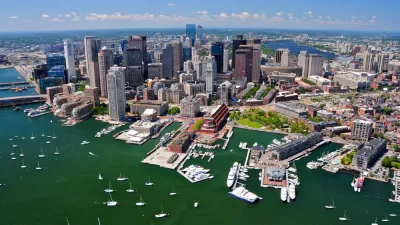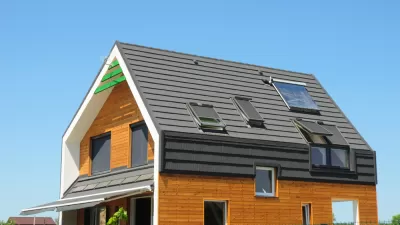The energy costs of big houses on big lots overshadow the benefits of energy efficiency.
As we have reported here before, the built environment is the single largest consumer of materials, and these energy expenditures account for 42 percent of all greenhouse gasses emitted in the United States.
Even though "energy efficiency" has become a very popular consumer product since the environmental movement of the 1970s took off, American single-family houses have doubled in size since then, and they are full of much more energy-sapping stuff.
"Energy intensity, or the units of energy expended per household, has actually increased since the early 1980s, with the average home using 183 million British thermal units (Btu) in 1981 and 188.7 million in 2011," reports Aarian Marshall.
Where there was once one TV in one modest living room, there are now many TVs in many rooms. Add to that laptops, robots, sound systems, security systems, heating and cooling systems and the myriad kitchen appliances and handy gadgets that accommodate modern life: it’s a lot of energy-hungry stuff.
Apartments and mobile homes, however, have made modest but significant declines in overall energy consumption. Since 1970, apartments with 2-5 units have decreased energy usage by five percent; apartments with five or more units have slashed 12 percent; and mobile home consumption is down eight percent.
Marshall warns: "Many Americans may still want a single-family home in the suburbs, but that’s not the path to an energy efficient future."
FULL STORY: America’s Increasingly Large Homes Are Making Us Less Energy Efficient

Alabama: Trump Terminates Settlements for Black Communities Harmed By Raw Sewage
Trump deemed the landmark civil rights agreement “illegal DEI and environmental justice policy.”

Planetizen Federal Action Tracker
A weekly monitor of how Trump’s orders and actions are impacting planners and planning in America.

The 120 Year Old Tiny Home Villages That Sheltered San Francisco’s Earthquake Refugees
More than a century ago, San Francisco mobilized to house thousands of residents displaced by the 1906 earthquake. Could their strategy offer a model for the present?

Ken Jennings Launches Transit Web Series
The Jeopardy champ wants you to ride public transit.

BLM To Rescind Public Lands Rule
The change will downgrade conservation, once again putting federal land at risk for mining and other extractive uses.

Indy Neighborhood Group Builds Temporary Multi-Use Path
Community members, aided in part by funding from the city, repurposed a vehicle lane to create a protected bike and pedestrian path for the summer season.
Urban Design for Planners 1: Software Tools
This six-course series explores essential urban design concepts using open source software and equips planners with the tools they need to participate fully in the urban design process.
Planning for Universal Design
Learn the tools for implementing Universal Design in planning regulations.
Clanton & Associates, Inc.
Jessamine County Fiscal Court
Institute for Housing and Urban Development Studies (IHS)
City of Grandview
Harvard GSD Executive Education
Toledo-Lucas County Plan Commissions
Salt Lake City
NYU Wagner Graduate School of Public Service





























